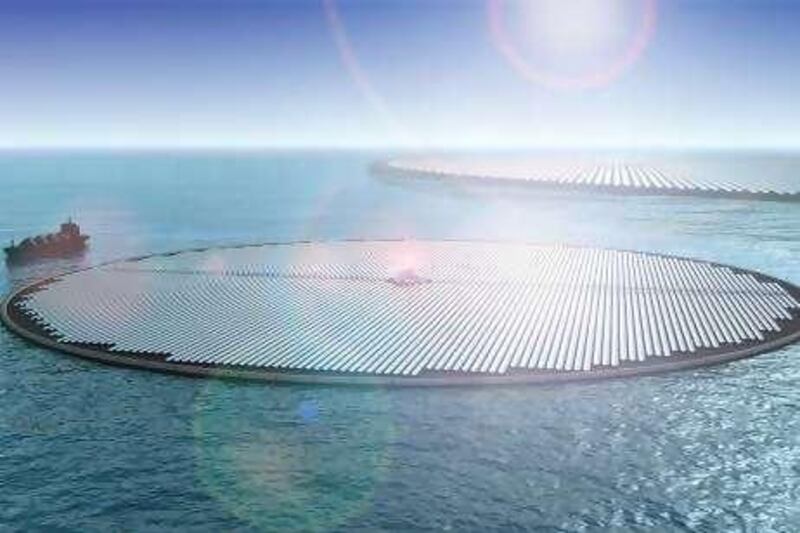RAS AL KHAIMAH // A series of floating, rotating solar islands off the coast of RAK could be the solution to the emirate's energy woes. Heat generated from the solar panels creates steam in an underwater tank, piped to a turbine on shore. A prototype is in the testing phase and statistical results are expected in two years, with real-world applications coming afterwards.
A small solar island with a diameter of 88 metres, like the prototype being tested in the RAK desert, can produce up to 1 megawatt (MW) of thermal power and would be able to cool or heat a small mall. Larger islands between 500m to 5km in diameter can produce between a tenth of a MW to several gigawatts (GW) of thermal power. "It's the biggest precision mechanism Swiss technology has ever made," said Dr Hamid Kayal, chief executive of CSEM-UAE, the company behind the solar-island prototype.
The idea of a solar island is not new. Five years ago, the RAK government teamed up with a Swiss research centre called La Centre Suisse d'Electronique et de Microtechnique (CSEM) to create a prototype that would marry academic knowledge with business know-how. "The basic technology is known and it works," Dr Kayal said. "The problem is not in the technology, the problem is using it in a reliable and an effective way.
"The prototype is not to show we can produce electricity; it is to show how economically we can produce it, at what size, and where." Much of this comes down to economies of scale. The CSEM-UAE islands may range from 500m to 5km in diameter, hovering up to 20m off the ground. "Testing the island from a mechanical point of view is a priority, and this will lead to some conclusions about the size and economic aspect," said Dr Kayal.
"The aim of the study is to see if and with which size we can compete with the present cost of electricity." The first stage involves testing the mechanics. In the first test, the 250-tonne platform was lifted using no more power than is needed to run four hairdryers. The second test measured its rotation, and a two-week test last month measured its accuracy at tracking the sun, confirming that the prototype can track the sun to within 0.02 degrees of precision.
The next step will be to optimise the structure of the solar radiation collectors on the platform and test their stability and reliability against the elements, dirt and wind. The final step will be designing a profitable thermal structure with an efficient thermal to electrical conversion. The islands can be installed on shore as well as at sea, and large islands could be connected to a grid, while smaller ones will probably be better suited for distinct industrial applications.
"We need to have a structure that is not consuming the energy it produces," said Dr Kayal. "We are studying whether there is a market for this," he said, adding that RAK-based companies had already consulted CSEM-UAE for advice on immediate energy solutions. If this prototype proves successful, CSEM-UAE will build a 500m-diameter island. Funding is provided by the RAK government on a six-month basis with step-by-step objectives.
"The government of RAK is expecting that we come with results very fast," Dr Kayal said. When this stage of the project is finished, the island prototype will be used for research into other applications that require direct heat from the sun to produce district cooling or to desalinate water. "If we do not find that this is going to give a real advantage to the electrical way of heating in a few years we can use it to experiment on ways to save electricity," Dr Kayal observed.
CSEM-UAE is collaborating with Sweden's Royal Institution of Technology in Sweden and research institutes in Switzerland and Dubai. Work is ongoing to open a research centre within the next three months to study the economical scale of solar cooling. The Ras Al Khaimah Investment Authority has donated 60MW of industrial waste heat that CSEM-UAE will use to study the economical effectiveness of using waste heat for cooling and water desalination.
"Our aim is to study how we can make a project out of it. Bring it from a concept to an economic solution," said Dr Kayal. "Today, if you take cooling for one room it is feasible but it's not economical. The objective is to bridge between real academic knowledge and real economic need." Ras al Khaimah has 0.1 per cent of the country's oil reserves and 0.6 per cent of the gas reserves, and consequently many businesses rely on generators for their power.
Last year, a report by Oxford Business Group cited power shortages as the biggest bottleneck to the emirate's industrial sector, which uses 35 to 55 per cent of the emirate's power supply. azacharias@thenational.ae






